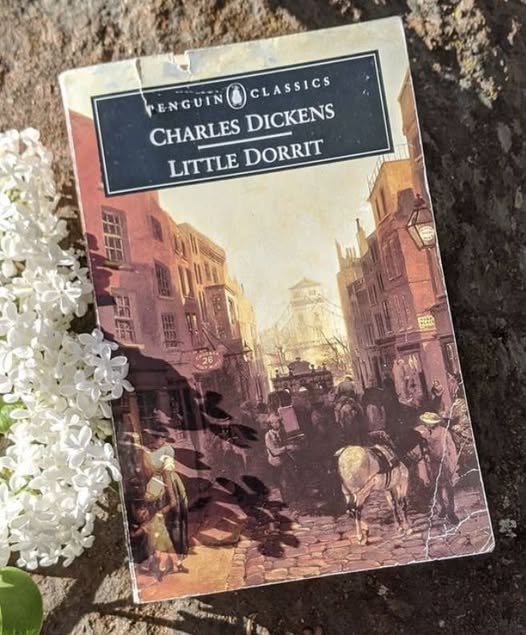“Little Dorrit” is a novel by Charles Dickens, first published in serial form between 1855 and 1857. It stands as one of Dickens’s most profound social critiques, exploring themes such as poverty, imprisonment, class disparity, and the absurdities of bureaucratic systems. Through a richly layered narrative and a wide array of memorable characters, Dickens exposes the flaws of British society, particularly its indifference toward the poor and the corruption that permeates its institutions.
The story centers on Amy Dorrit, affectionately known as Little Dorrit, who was born and raised in the Marshalsea debtors’ prison, where her father, William Dorrit, had been confined for many years due to unpaid debts. Despite her harsh upbringing, Amy remains gentle, kind-hearted, and dutiful. She earns a living through sewing and dedicates herself entirely to caring for her father and supporting her struggling family. Her quiet dignity and compassion sharply contrast with the selfishness, greed, and moral shortcomings of those around her.
The narrative begins when Arthur Clennam, a middle-aged man returning to England after years abroad, becomes intrigued by the Dorrit family. His curiosity is sparked by a mysterious watch given to him by his stern mother, which contains a cryptic message hinting that the Clennam family may have wronged the Dorrits. Arthur’s search for the truth draws him into the world of the Marshalsea and its inhabitants, particularly Amy, with whom he develops a deep emotional connection.
In a dramatic twist, William Dorrit inherits a large fortune, and the Dorrit family is suddenly released from prison. They attempt to enter high society as wealthy individuals, but this change of fortune brings unforeseen challenges. William, long accustomed to the humiliations of poverty, struggles to adapt to his newfound wealth and social status. The family, too, finds it difficult to discard the habits, anxieties, and insecurities shaped by years of deprivation, highlighting Dickens’s point that wealth cannot easily erase the marks of hardship.
One of the novel’s most memorable creations is the Circumlocution Office, a fictional government department that serves as a biting satire of bureaucratic inefficiency and corruption. Through this portrayal, Dickens ruthlessly criticizes red tape, incompetence, and the self-interest that characterize government institutions. The Circumlocution Office symbolizes the obstacles faced by ordinary people seeking justice or progress in a system designed to maintain its own power.
Meanwhile, Arthur Clennam faces his own series of misfortunes. Despite his integrity and good intentions, he becomes entangled in disastrous business ventures that ultimately lead to financial ruin and imprisonment in the Marshalsea, the very place where the Dorrits once lived. Throughout his downfall, Amy remains steadfast and loyal, supporting him even after her family’s rise and subsequent fall. Her compassion and inner strength remain constant despite the shifting tides of fortune.
Tragedy strikes again when William Dorrit dies after losing his fortune due to the collapse of the bank holding his wealth. Left alone once more, Amy continues to live humbly, devoted to caring for those she loves. In the end, Arthur comes to fully recognize the depth of Amy’s goodness and his own affection for her. The novel concludes with their marriage, a quiet yet deeply moving resolution symbolizing endurance, love, and moral triumph over adversity.
Thematically, Little Dorrit explores the contrasts between poverty and wealth, showing that both can function as forms of imprisonment. Dickens demonstrates how society traps individuals, whether through economic hardship or through the moral corruption that often accompanies affluence. The motif of imprisonment recurs throughout the novel, not only through the literal confines of the Marshalsea but also in the emotional and psychological entrapment experienced by characters such as Mrs. Clennam, who is imprisoned by guilt and rigidity.
Another central theme is Dickens’s critique of bureaucracy. The Circumlocution Office embodies his frustration with inefficient government systems that hinder reform and perpetuate inequality. In contrast, Amy Dorrit exemplifies selflessness and moral integrity; her compassion, humility, and unwavering dedication serve as the ethical core of the story.
Upon publication, Little Dorrit was warmly received and remains a significant part of Dickens’s literary legacy. Critics and readers alike have praised its intricate structure, vivid characters, and sharp social commentary. Its condemnation of institutional corruption and class inequality resonated with Victorian audiences and continues to be strikingly relevant today. Amy Dorrit, with her quiet courage and steadfast moral compass, is celebrated as one of Dickens’s most beloved heroines.
Little Dorrit is more than a story of personal struggle and redemption. It is a sweeping critique of the social injustices of nineteenth-century England, exposing how wealth, power, and pride can imprison the human spirit as effectively as iron bars. Through Amy’s unshakable goodness, Dickens presents a vision of compassion and integrity that transcends societal failures, making Little Dorrit both a profoundly human story and a timeless commentary on inequality.

